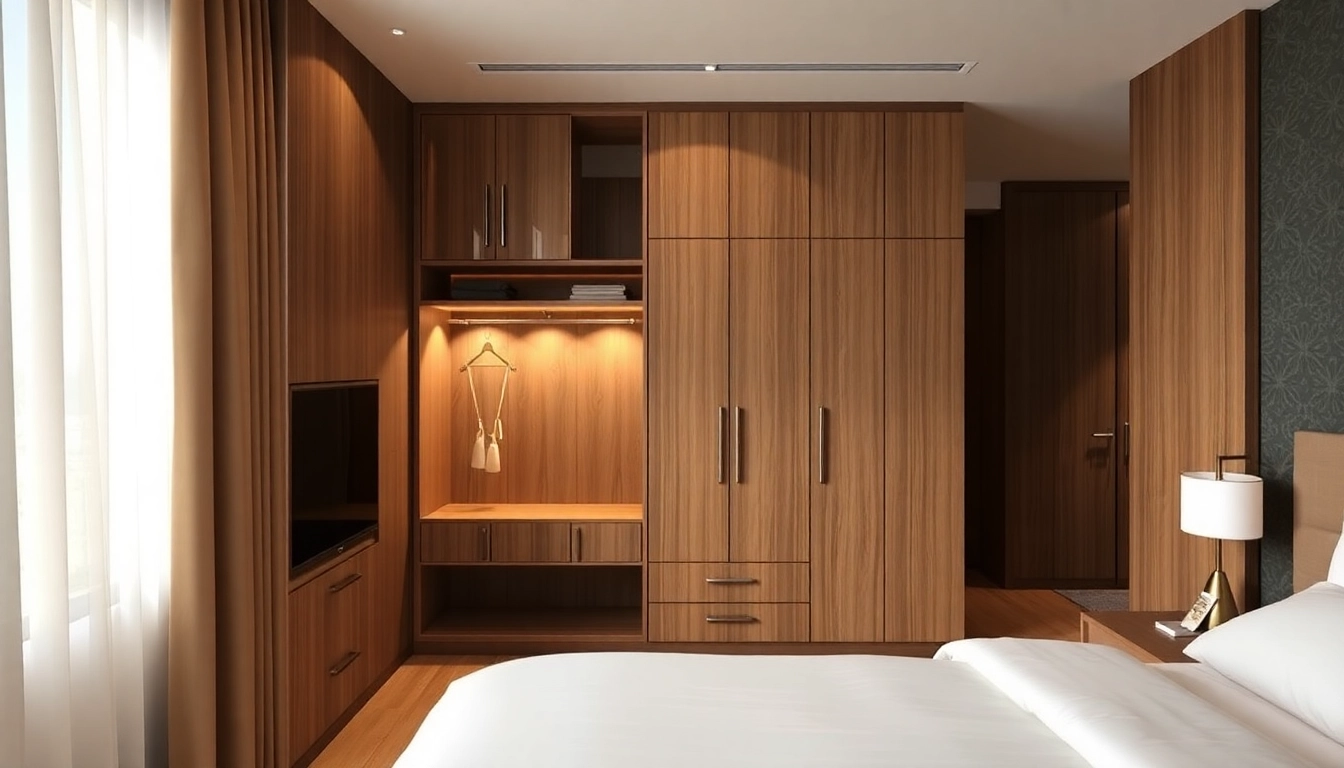1. Importance of Hotel Room Wardrobes for Guest Experience
1.1 Enhancing Functionality and Storage
In the hotel industry, first impressions are crucial, and nothing sets the tone for a guest’s stay quite like the room’s furnishings. One pivotal element that can either enhance or hinder a guest’s experience is the Hotel Room Wardrobes. These essential fixtures not only provide essential storage solutions for guests but also contribute to the overall aesthetic and functionality of the space.
Well-designed wardrobes enhance functionality by offering segmented storage for clothing, luggage, and personal items. Many modern hotel wardrobes come equipped with a plethora of features, such as built-in drawers, hanging racks, and even shoe compartments to help guests organize their belongings. This level of thoughtful organization not only allows guests to unpack and settle in quickly but promotes a sense of comfort and ease, significantly enhancing their overall hotel experience.
1.2 Aesthetics and Interior Design
The aesthetic appeal of hotel room wardrobes serves to elevate the overall décor of the guest room. The choice of materials, color schemes, and design styles can reflect the hotel’s branding and enhance its theme. For instance, luxury hotels often opt for high-end finishes such as hardwood or bespoke cabinetry, while boutique hotels might favor creative, eclectic designs that stand out. This attention to detail not only attracts guests but also profoundly impacts their emotional response, making them more likely to appreciate the hospitality they receive.
1.3 Impact on Guest Satisfaction
Ultimately, the presence and quality of hotel room wardrobes can significantly influence guest satisfaction ratings. Research has shown that when guests find their accommodation well-furnished with adequate storage solutions, they report higher levels of satisfaction during their stay. Such satisfaction is integral, as it can lead to repeat bookings and positive word-of-mouth referrals—two critical aspects of a hotel’s success. Therefore, investing in stylish and functional wardrobes is not merely a matter of aesthetics; it is a marketing strategy that directly correlates with guest satisfaction.
2. Key Features of Hotel Room Wardrobes
2.1 Materials and Finishes
The materials and finishes used in hotel room wardrobes are crucial in determining their durability and appearance. Common materials include solid wood, which offers a classic and timeless look, yet may come with a higher price tag. Alternatives like plywood or particleboard can provide elegance at a lower cost and are increasingly being utilized in cost-sensitive establishments. Additionally, materials can be treated with finishes that enhance resilience against wear and tear while adding to the overall design ethos of the space.
Eco-friendly materials and finishes have also gained traction as hotels recognize the importance of sustainability. Recyclable materials, natural wood stains, and finishes free from harmful chemicals not only appeal to environmentally conscious travelers but also position the hotel favorably in today’s competitive market.
2.2 Space Optimization Solutions
Modern hotel room wardrobes are no longer just simple closets; they encompass innovative space optimization solutions that maximize utility in often limited room layouts. Features such as sliding doors, corner wardrobes, and modular designs allow hotels to make the most of their available space while maintaining an elegant appearance.
Another notable trend is the incorporation of multi-functional pieces, such as wardrobes that come with built-in luggage racks or integrated lighting systems. These thoughtful touches not only streamline the experience for guests but also demonstrate a hotel’s commitment to guest convenience and comfort.
2.3 Customization Options for Hotels
Customization is a significant aspect of selecting hotel room wardrobes, as it allows hotel operators to align furnishings with their brand identity and guest expectations. Initially, hotels may work with designers to choose styles and finishes that reflect the overall theme of the space. Furthermore, bespoke solutions can provide features tailored to the specific needs of a property or its target demographic. For example, family-oriented hotels might opt for wardrobes that include extra storage for children’s items, while business hotels might focus on modern designs that cater to executives traveling for work.
3. Trends in Hotel Room Wardrobe Design
3.1 Sustainable and Eco-Friendly Choices
Sustainability is no longer a passing trend; it has become integral to the hotel industry. With increasing environmental awareness among travelers, hotels are making strides to integrate sustainable practices into their designs, including the wardrobes they choose. Utilizing reclaimed wood, bamboo, or other rapidly renewable materials signifies a hotel’s commitment to eco-friendliness.
Additionally, the implementation of energy-efficient lighting within wardrobes or spaces dedicated to recycling is becoming more commonplace as hotels aim to enhance their sustainability credentials while still satisfying guest preferences.
3.2 Smart Storage Innovations
The advent of technology has also paved the way for innovations in hotel room wardrobes. Smart storage solutions, such as automatic lighting that activates when a wardrobe is opened or systems that alert housekeeping when a guest needs items replaced, offer unparalleled convenience. These advanced features not only improve the guest experience but help hotels manage their operations more efficiently, such as tracking usage patterns to develop better inventory systems.
3.3 Aesthetic Varieties: Contemporary to Classic
Aesthetic preferences vary widely among hotel guests, leading to a diversity of design choices in hotel room wardrobes. Some hotels opt for contemporary styles, characterized by minimalistic design, sleek lines, and neutral color palettes that appeal to millennial and Gen Z travelers. Alternatively, others embrace classic or vintage looks that evoke nostalgia and charm.
Whichever path is chosen, attentiveness to aesthetic coherence across all hotel furnishings is crucial for creating a harmonious atmosphere that resonates with guests and enhances their overall stay.
4. Selecting the Right Wardrobe for Your Hotel
4.1 Evaluating Space and Layout
Choosing the right wardrobe begins with understanding the spatial constraints and layout of each guest room. Conducting a thorough assessment allows hotel managers to identify potential areas where wardrobes can fit without obstructing movement or disrupting the overall design flow. For smaller rooms, the lean toward wall-mounted or hidden wardrobes can save space while providing much-needed storage.
4.2 Budget Considerations and Cost-Effectiveness
Budget constraints often dictate the types of wardrobes hotels can consider. While luxury materials and intricate designs may be desirable, practicality is key. A thorough cost-benefit analysis should be conducted to weigh the initial investment against long-term returns, such as guest satisfaction and potential repeat business. Sometimes, opting for high-quality knock-offs or modular furniture can offer a perfect balance between aesthetics and budget constraints.
4.3 Collaborating with Furniture Manufacturers
Collaborating with reputable furniture manufacturers is essential for securing quality wardrobes tailored to hotel needs. It is crucial to communicate clearly with manufacturers about design concepts, materials, timelines, and installation processes to avoid costly delays and ensure a smooth workflow. Choosing a manufacturer with experience in the hotel sector can provide insights into the best practices and emerging trends, allowing hotels to stay ahead in a competitive marketplace.
5. Maintenance and Longevity of Hotel Room Wardrobes
5.1 Care Guidelines for Different Materials
Once hotel room wardrobes are installed, a maintenance plan should be established to ensure their longevity. Different materials require varied care; for example, wood should be treated with appropriate cleaners to prevent damage, while metal components may benefit from anti-corrosion treatments. Regular inspections can help identify wear and tear before it becomes a significant issue.
5.2 Repairing and Restoring Wardrobe Features
In the event of damage or excess wear, quick action is essential. Establishing a relationship with local repair services can expedite the process, ensuring that wardrobes remain in top condition. Some hotels may even train in-house staff to handle minor repairs to maintain aesthetic quality and prevent considerable downtime for guest rooms.
5.3 Future-Proofing Your Wardrobe Investment
Future-proofing means investing in designs and materials that are not only current but are built for longevity and sustainability. Select wardrobes that can adapt to changing aesthetic trends or multi-functional designs that accommodate evolving guest needs. Moreover, choosing components and materials that can easily be replaced or updated will ensure wardrobes remain functional and appealing for years to come.








